Geography Reference
In-Depth Information
Europe was locked in the battles of World War I
(1914-1918), and China hoped that by supporting
Britain and France against Germany , it would gain their
support against the Japanese. The terms of the 1919
T Treaty of Versailles therefore came as a shock to China.
Japan was allowed to keep its territorial gains in China
and the Europeans kept all their treaty ports and privi-
leges both along the coast and along the Yangzi.
Students led a nationalistic demonstration that
sparked a nationwide strike. One of the strike leaders was
a young teacher named
Mao Zedong
(Mao Tse-tung).
Communism attracted many young students with its
promises of equality , and the logic of Marx and Engels
appealed to many Chinese Confucian intellectuals. A
Chinese Communist Party (CCP) was created and held
its First National Congress in Shanghai on July 1, 1921.
Warlordism continued, however, as the Kuomintang
(KMT) tried to revitalize itself with Russian assistance.
Unfortunately , Sun Yat-sen, often referred to as the first
great Asian nationalist, was unable to complete his mis-
sion. Suffering from cancer, he died on March 12, 1925.
KMT leadership was assumed by
Chiang Kai-shek
.
made a savage attack on Shanghai. Because Chiang was
unwilling to give up his campaign against the Commu-
nists to fight the Japanese, the Japanese were able to set
up the puppet state of
Manchukuo
in Manchuria—
China' s most important industrial region.
The Nationalists continued their extermination cam-
paign against Mao and his Red Army . In eastern China, the
Communists, who were not faring well in battle, decided to
move elsewhere to reorganize and reconsider their options.
In October 1934, 85,000 made the now famous
Long
March
(Figure 10-17). Pursued relentlessly by the Nation-
alists, they trudged 6,000 miles (9,660 km) through jun-
gles, swamps, hostile tribal areas, across torrential rivers,
and through 16,000-foot (4,800 m) mountains. About
7,000 people survived the march and set up their capital at
Y enan in the loess hills of Shensi Province in October 1935.
The Long March became a legend, an epic story of
the heroism of soldiers and loyal peasants who placed
national interests before individual concerns. The Long
March exemplifies struggle for an ideal.
In 1937 the Nationalists and Communists decided to
form a temporary united front against Japan. As the
Japanese advanced, Chiang moved his capital to
Chongqing (Chungking), which he proceeded to indus-
trialize with dismantled factories from the east.
The Road to Communism
Outwardly allies, Mao Zedong' s CCP and Chiang Kai-
shek' s KMT proceeded to fight the warlords. Strikes,
riots, and rebellions wracked the countryside, yet foreign
powers continued to pour money into urban industrial-
ization. Disruption in the rural areas drove millions of
refugees to these cities, which became breeding grounds
for secret societies, strike units, and rebel organizations.
Meanwhile, the CCP was working toward a Communist
revolution and had formed peasant organizations in the
countryside to carry it forward. These would eventually
rise up and annihilate the KMT .
Following a northward sweep by the combined KMT
and CCP , which together conquered most of southern
China by 1927, Chiang Kai-shek decided to rid China of
the CCP . Launching a reign of terror in newly captured
cities such as Shanghai, he routed out and executed as
many Communists as possible. The Communists fled the
cities and vowed to garner the loyalty of the peasants and
regroup. Chiang set up his government in Nanjing and
proclaimed it capital of the Nationalist Republic of China
in 1928.
Chiang Kai-shek and his troops followed the Com-
munist forces, determined to exterminate them. But in
1931, the Japanese invaded Manchuria, with profound
consequences for all factions. The following year they
Figure 10-17
The Long March, from October 1934 to October 1935, was one of
the most arduous journeys ever made by people. Mao and his fel-
low Communists travelled more than 6,000 miles (9,660 km)
across snow-covered mountain ranges with passes at 16,000 feet
(4,800 m), into lands inhabited by wild tribal people, and through
deserts and swamps. Only 7,000 of Mao' s forces completed the
route to the relative safety of the loess caves of Y enan.


















Search WWH ::

Custom Search